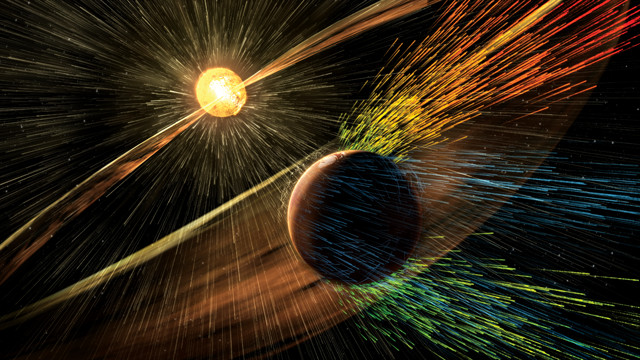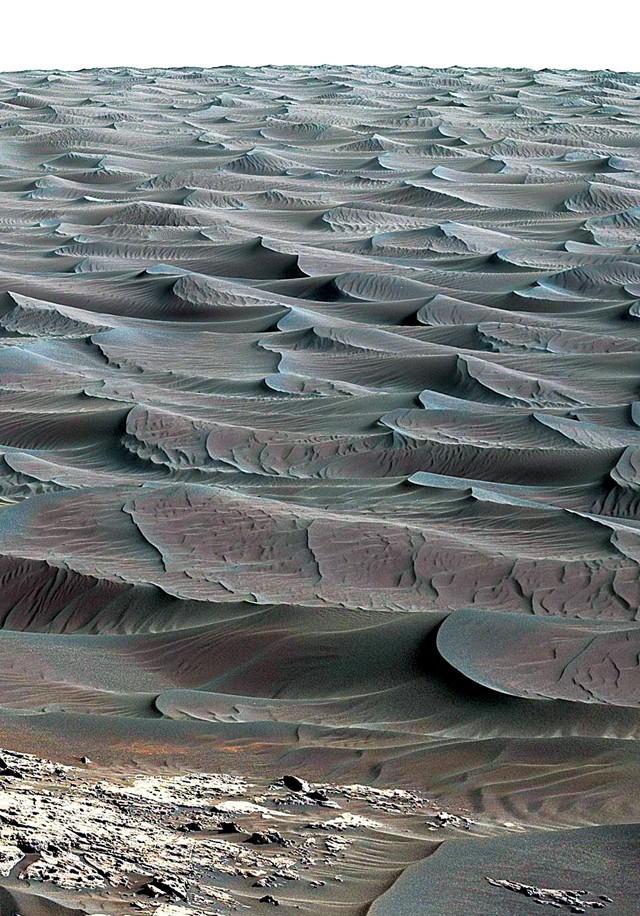
by Timothy Oleson Wednesday, March 2, 2016

A solar storm strips ions from Mars' upper atmosphere in this artistic rendering. Credit: NASA/GSFC.
“With two rovers patrolling the surface of Mars, five spacecraft orbiting above it, and scientists here on Earth studying the Red Planet from afar, new findings are announced often. Here are a few of the latest updates.
The solar wind, which continues to strip away Mars’ thinning atmosphere today, may be largely responsible for the planet’s transition from the warm and wet place many scientists suspect it was early in its history to the frigid desert world it is now. In dozens of studies published simultaneously in Geophysical Research Letters and Science in November, members of NASA’s Mars Atmosphere and Volatile EvolutioN (MAVEN) mission reported data collected by the spacecraft since September 2014, when it arrived in orbit around Mars. Among the notable findings, researchers reported that electrons and protons in the solar wind ionize and strip away about 100 grams of Martian atmosphere every second, mostly from where the solar wind tails around the back of the planet, as well as from plumes above Mars’ poles. In situ observations of the planet’s atmosphere during a series of solar storms in March 2015 showed that the loss rate accelerated during these events. “We’ve seen that the atmospheric erosion increases significantly during solar storms, so we think the loss rate was much higher billions of years ago when the sun was young and more active,” said MAVEN principal investigator Bruce Jakosky, in a statement. Prolific solar activity combined with Mars’ weak gravitational pull (owing to its small size) and magnetic shield might thus have led to the loss of much of the planet’s thicker early atmosphere.
Phobos, the larger of Mars’ two moons, is locked in a death spiral that’s bringing it ever closer to the planet and ultimately dooming it to disintegration — either in a collision with Mars or as strengthening tidal forces shatter the moon while it’s still orbiting. The latter seems more likely based on a new study in Nature Geoscience. Benjamin Black and Tushar Mittal of the University of California at Berkeley modeled the orbital evolution of, and tidal stresses, on Phobos, accounting for remotely sensed data describing the geology and cohesiveness of the rocky moon. The modeling revealed that, sometime between 20 million and 40 million years from now, much of Phobos — which is thought to be weakly held together — will break apart in orbit, rapidly forming a debris ring around Mars similar to those around Saturn. The ring should then persist for 1 million to 10 million years, the researchers reported.
In early December, NASA announced that the Curiosity rover reached a patch of active dark sand dunes — part of a larger area named Bagnold Dunes — on its way up the lower slopes of Mount Sharp, where it has been examining the landscape since September 2014. Although active dunes have been observed from orbit previously, this is the first opportunity to study such features up close. Individual dunes are up to two stories tall, according to NASA, and migrate at up to 1 meter per year.

Ripples of sand cover the surface of High Dune in the Bagnold Dunes near Mount Sharp. Curiosity scientists recently had their first chance to study such features up close instead of only from orbit. Credit: NASA/JPL-Caltech/MSSS.
The vast majority of Mars is composed of low-silica basalt, but scientists keep finding clues that the planet isn’t so monolithic after all. After arriving at Marias Pass near the base of Mount Sharp last May, Curiosity began analyzing the local geology with the help of its ChemCam and CheMin instruments and found areas composed of silica-enriched rock — some up to 90 percent silica. “The type of silica phase that’s present can tell us about the processes that were once occurring in those rocks,” said Liz Rampe of Aerodyne Industries at NASA Johnson Space Center, one of the Curiosity team members who reported on recent research in a press conference at the fall meeting of the American Geophysical Union in San Francisco. Among the silica phases observed was tridymite, a rare mineral on Earth found mostly in volcanic rhyolite but one that hasn’t been seen on Mars before. “We could’ve never predicted this result,” Rampe said, in part because the rocks at Marias Pass in which it was found aren’t volcanic. The story of how the tridymite and the overall silica enrichment formed or collected at Mount Sharp is unknown, but it clearly involves the work of multiple generations of flowing water, noted Ashwin Vasavada of NASA’s Jet Propulsion Laboratory (JPL) during the press conference. “We’re continuing to traverse through [the area with Curiosity] and we’ll hopefully find additional clues to help answer this puzzle that Mars has presented us,” he said.
Ongoing problems with the main instrument in the science payload of NASA’s upcoming Mars lander mission, called Interior Exploration using Seismic Investigations Geodesy and Heat Transport (InSight), have led the agency to suspend the mission’s planned launch in March. The troubled instrument is a seismometer called the Seismic Experiment for Interior Structure that was built for the mission by France’s National Center for Space Studies to help scientists study Mars’ interior in more detail than ever before. However, in tests held last December in France designed to simulate the harsh conditions it will face in space and on Mars, the instrument was unable to maintain the necessary vacuum seal despite attempts to correct the problem. After the setback, NASA officials concluded there was too little time left before the launch date to correct the issue and complete necessary testing. They expressed relief, however, at having identified the problem prior to the spacecraft’s launch, as well as confidence that the mission will be ready before the next potential launch window in 2018. “It is more important to do it right than take an unacceptable risk,” said JPL Director Charles Elachi in a statement.
© 2008-2021. All rights reserved. Any copying, redistribution or retransmission of any of the contents of this service without the expressed written permission of the American Geosciences Institute is expressly prohibited. Click here for all copyright requests.